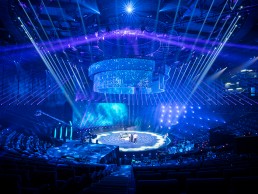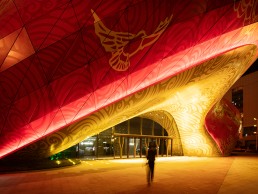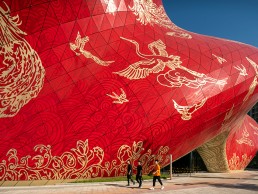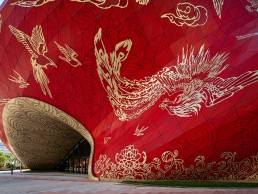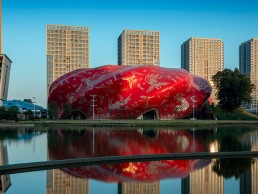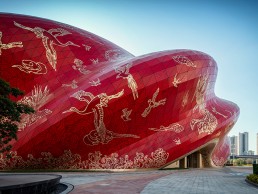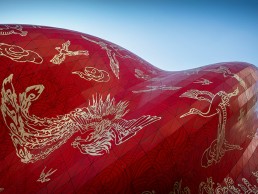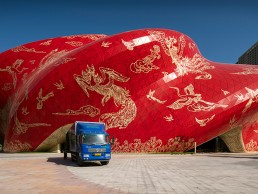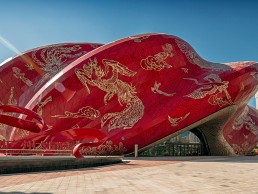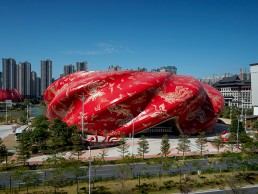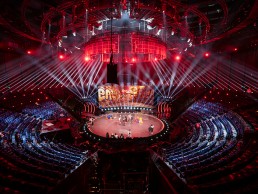This website uses cookies so that we can provide you with the best user experience possible. Cookie information is stored in your browser and performs functions such as recognising you when you return to our website and helping our team to understand which sections of the website you find most interesting and useful.
Sunac Guangzhou Grand Theatre
ProjectSunac Guangzhou Grand TheatreLocationGuangzhou, ChinaManufacturers L-Acoustics, AVID, Shure, Terbly, Fine Art, Robe, ETC, MA Lighting, LOPU, PanasonicArchitectSteven Chilton ArchitectsAcoustician The Beijing Institute for Architectural Design (BIAD)Theatre and Audiovisual ConsultantAuerbach Pollock FriedlanderSubmitted by Auerbach Pollock Friedlander
At first glance, the Sunac Guangzhou Grand Theatre looks like a palace from the set of a Disney movie. The breathtaking structure, embellished with Chinese silk embroidery patterns, is not only a tribute to tradition, but a space that combines unmatched architecture with state-of-the-art audiovisual capabilities. Located in the Huadu District of Guangzhou, China, the 2,000 seat, purpose-built theatre is where it belongs, in a place that has been the home of and inspiration for artists who have helped to define the worlds’ concept of Chinese culture for thousands of years.
The architects behind the theatre’s distinctive design, Steven Chilton Architects (SCA), aimed to channel the history, emotion and creative energy of the city. This sense is magnificently captured in the incorporation of silk. Silk has been painted and embroidered by fine artists in Guangzhou for thousands of years and developed as a creative medium for depicting myths and scenes of nature on tapestries and ornamental robes.
The physicality of silk cloth informs the formal expression of the building through a series of 10 gently twisting folds that define the outer envelope. The various entrances into the building are created by ‘tucking’ the surface in on itself where the valley of each fold would meet the ground plane. Each entrance is protected by a natural canopy created by the overhanging surface before it ‘tucks’ in to define the opening.
The theatre’s mission to cultivate talent is expressed through the imagery applied to the surface of the cladding. Steven Chilton, Director of SCA said: “We were influenced by a beloved local myth, ‘100 Birds Paying Homage to the Phoenix’. The Phoenix or ‘Fenghuang’ stands for virtue and grace, whilst the allegory signifies notions of recognition, leadership and mentoring.”
Using illustrations created by artist Zhang Hongfei, SCA digitised and interpreted his hand drawings before mapping each figure onto the surface geometry. The team then developed a compositional style inspired by tattoo art aesthetics. Each figure was positioned on the body of the theatre over a series of studies in response to the topology of the surface geometry. While significant figures like the Phoenix were positioned where the form afforded prominence, lesser figures such as birds, were organically and less consciously arranged in the spaces between.
The cladding is composed of thousands of perforated aluminium panels, each painted with a unique portion of the overall composition. They are supported by a complex structure of welded steel tubes that work interdependently with the concrete superstructure supporting the theatre floors. Inside the theatre, the auditorium concept design led by Dragone, with theatre consultant, Auerbach Pollock Friedlander, is an immersive performance environment that can be transformed from a more typical 360º theatre into any number of alternate configurations.
The project was a real team effort from the beginning as Auerbach Pollock Friedlander worked closely with the theatre’s owners and end-users to develop a fast-track method of phasing the audiovisual design process to allow the foundation work to begin. The owners first wanted an audio system that provided the highest quality of enveloping surround sound for the reinforcement of voices, music and effects playback. Paul Garrity, Auerbach Pollock Friedlander’s Audiovisual Designer, explained further: “In the beginning stages of the project, a collaboration was established with the Sunac production audio system designers so that we could look at the needs of the theatre and the production requirements anticipated within the venue.
“Early studies were undertaken for loudspeaker type and placement, coordinating all efforts with other design disciplines. EASE and other computer modelling software was employed to assist in the loudspeaker array design to ensure that proper coverage, SPLs, directivity and sonic quality would be achieved. Several types of loudspeakers and equipment were carefully considered prior to making a final choice of brand and type. Once the basic elements of the design were agreed, the detailed design of the integration of the systems into the building structure was undertaken to ensure that there would be sufficient power, cabling containment, rigging elements and other related and necessary equipment to establish the infrastructure.”
For the theatre’s sound system, Auerbach Pollock Friedlander and the theatre’s system designers specified L-Acoustics KARAi, KIVA II, KS28 and X12 Series loudspeakers, with their associated LA-Series power amplifiers. The loudspeaker arrays and subwoofers are placed in discrete locations, so they don’t intrude on the aesthetic of the room or interfere with the rigging of scenic elements and acrobatic performances. The design also allows for additional touring systems to be deployed for the needs of specific productions and performances.
Providing sound coverage in an in-the-round theatre can present challenges for sound reinforcement and playback, so the system also makes use of a digital audio processing system that allows music and sound effects to be routed and mixed into any of the loudspeakers placed throughout the auditorium. Mixing and control is provided in an appropriate position within the performance seating area, or the system can also be operated from alternate locations as required by production needs.
Paul Garrity offered additional specifications about the sound system: “Over 111 high-powered loudspeakers are used. An AVID Venue S6L-32D-192 digital mixing surface console provides control of all the audio sources and distribution channels, using digital signal distribution to the stage. A Soundcraft Si Expression1 console is also provided for additional audio mixing control. Shure wireless performer in-ear monitors have been provided to ensure that key performers may hear music and cueing while on stage, with Shure wireless microphone transmitters and receivers used, too, for performer sound reinforcement.”
The sound processing for this project is handled directly in the AVID E6L-192 system processing engine and matrix. This system provides input processing such as HEAT (Harmonically Enhanced Algorithm Technology), high and low-pass filters, and four-band parametric equalisation. Output processing includes a seven-band parametric equaliser, as well as advanced compressor/limiter and delay. All inputs and outputs feature four plugin inserts and a hardware insert. The L-Acoustics power amplifiers also provide additional DSP processing support for control of each loudspeaker unit. Control is then provided at the AVID Venue S6L-32D-192 mixing surface. “This system provides the highest degree of mixing sophistication and control for theatrical live sound reinforcement and playback, so that’s why we knew it would be a perfect match for the Sunac Guangzhou Grand Theatre,” Paul commented.
Such a robust audio system would be incomplete without a lighting package to bring each performance to life, so the theatre had an extensive team of lighting designers working on getting the best local manufacturers on board with the project, too. They wanted a flexible lighting package, with the ability to add to the immersive experience of the performances. It was also important to the teams that the lighting fixtures were locally sourced for easy access to maintenance support and spare parts if needed. While the installed lighting positions and lighting trusses are intended to provide lighting for the stage area, it was important that these elements also be integral elements in the building and allow for the theatre to be enhanced with theatrical lighting.
The theatre’s primary lighting fixtures consist of Guangzhou based manufacturers, Terbly and Fine Art’s products configured flexibly throughout the venue, so that the space is able to adapt to various rental production uses. Sunac Guangzhou Grand Theatre also benefits from four Robe BMFL followspots and a range of ETC Source Four profile fixtures in varying degrees. One of the best parts of the theatrical and performance lighting aspect of the project was its collaborative aspect: “On projects like this, you work in a team with the theatre design and interior architectural of the building. We each impact the others’ work, so we collaborated to allow for an integrated interior and theatre design. Collaboration with the Sunac and architectural team was really essential.”
For lighting control, the Sunac Guangzhou Grand Theatre has two MA Lighting grandMA2 control consoles. The grandMA2 light is the perfect tool to control all kinds of lighting fixtures including: moving heads, LEDs, video and media. It supplies an intuitive and fast control of all connected fixtures and channels, and also has the ability to handle an almost infinite number of presets, cues, pages, sequences and effects.
The Sunac Guangzhou Grand Theatre is all about enhancing the experience even further, whether that’s in its daringly different façade, or through its multi-dimensional, immersive theatre productions, the venue knows how to put on a show that will stick with its audience forever. Its audiovisual expansion didn’t stop there, as the venue also installed a 360º overhead curved LOPU LED screen providing high-resolution images that surround the heads of each onlooker.
Paul furthered: “We chose LOPU LED display systems due to its high quality of imaging and processing power, coupled with its high commitment to client service.
The screen is complemented by a series of Panasonic video projectors, using sophisticated projection mapping software, allowing images to be placed and manipulated throughout the stage area. “We also chose Panasonic PT-SRZ Series high output laser phosphor projectors to provide the best possible quality of projected images, coupled with the rugged durability needed in a theatrical environment. Sophisticated computer control of video sources and mapping is provided using VYV Photon media servers and controllers.”
With its dreamlike exterior and subtle blend of tradition and talent, the Sunac Guangzhou Grand Theatre is a venue that is most likely at the top of any budding theatre goer or performer’s list. Thanks to the work of Auerbach Pollock Friedlander and the theatre’s system designers, its audiovisual capabilities are endless, and guests will be left feeling like they’ve plunged into their very own part of the performance. Rob Hill, Principal, Auerbach Pollock Friedlander, who worked with Len Auerbach on the project, concluded: “It was a great honour to work with Sunac, Steve Chilton and the Beijing Institute for Architectural Design. The project was fast tracked so the work below ground was accelerated. To help with this, APF has developed a collaborative method involving an intense amount of discussion about the design of stage machinery, audio, lighting and video. There were many unique technical demands for the Guangzhou show theatre, but by collaborating closely with all of the design team members the building is a huge success.”
